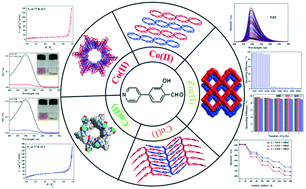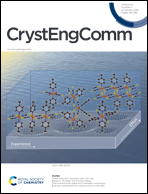Coordination polymers with salicylaldehyde ligands: structural diversity, selective sorption and luminescence sensing properties†
Abstract
Five new coordination polymers [Cu(L)2]·2CH2Cl2·CH3OH (1), [Co(L)2]·CH2Cl2·2CH3OH (2), [Zn(L)2]·CH2Cl2·CH3OH (3), [Co(L)2] (4) and [CuI(HL)] (5) [HL = 2-hydroxy-4-(pyridin-4-yl)benzaldehyde] have been successfully synthesized. 1 and 2 are 2-fold interpenetrated three-dimensional (3D) frameworks with a NbO topology and have large channels along the crystallographic c axis. 3 and 4 have different two-dimensional (2D) layer structures while 5 is an infinite one-dimensional (1D) Cu–I chain decorated by HL. The diverse structures of 1–5 result from the different coordination geometries of their metal centers and various reaction conditions. Moreover, 1 and 2 exhibit high selectivities for adsorption of Congo red (CR) among the tested dyes. In addition, 3 exhibits strong luminescence in the solid state and while suspended in methanol solution, and can be used as a chemical sensor for detection of antibiotics. The emission of 3 can be quenched efficiently by trace amounts of nitrofuran antibiotics (NFs) including nitrofurazone (NZF), nitrofurantoin (NFT) or furazolidone (FZD) with high selectivity and recyclability. The detection limits of 3 for NZF, NFT and FZD are 240, 246 and 414 ppb, respectively.

- This article is part of the themed collection: Introducing the CrystEngComm Advisory Board and their research


 Please wait while we load your content...
Please wait while we load your content...